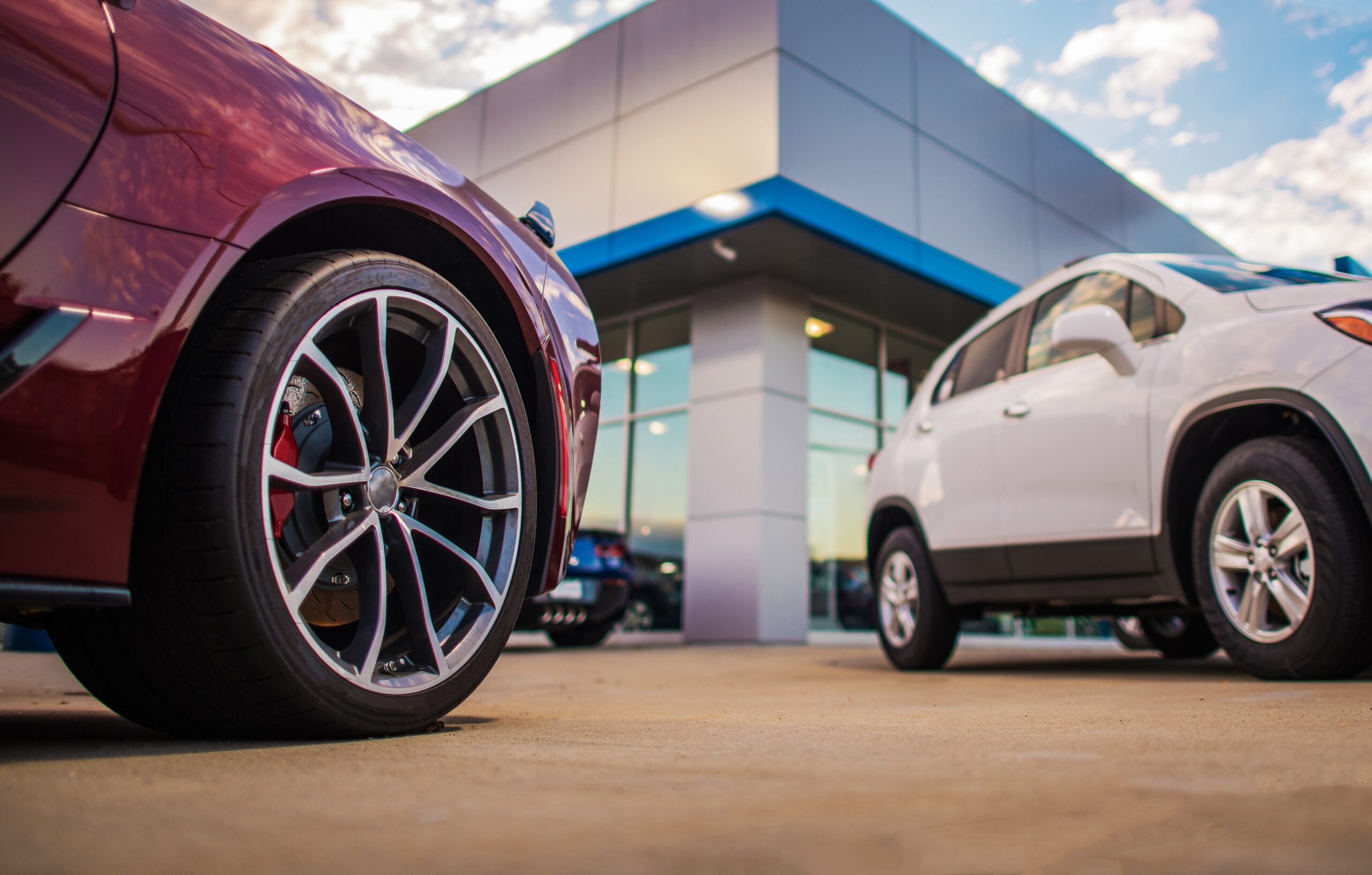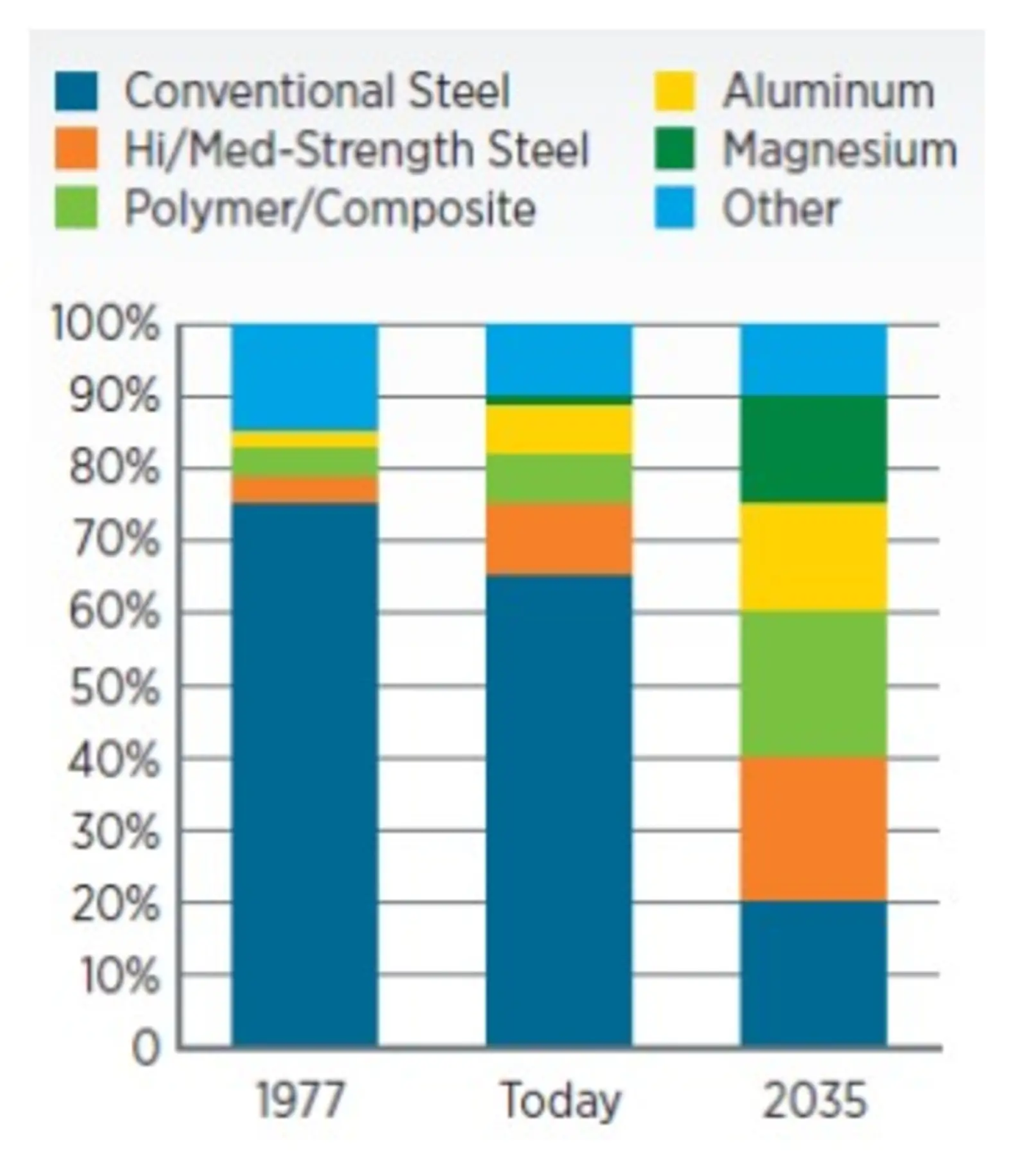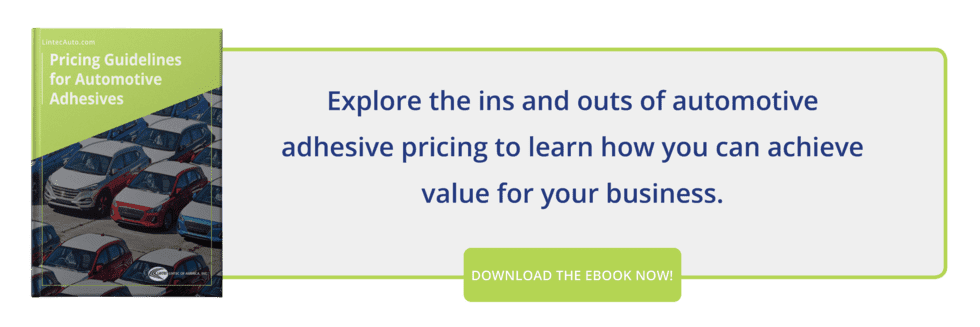How Automotive Tape Adds Value to Modern Vehicles

Adhesives have been adding value to human projects for a long time.
Cavemen in South Africa protected cave murals with an adhesive layer of tree sap and red ochre as much as 70,000 years ago. The ancient Egyptians used cartonnage (strips of linen or papyrus soaked in sticky plaster or resin—an early tape!) to bind and preserve their mummies, but also used it as a paintable, decorative surface. Early adhesives like these could magnify the splendor and longevity of paintings and buried kings far beyond the effort it took to apply them.
Automotive tapes have continued this trend in the 21st century. Mechanical fasteners like clips, screws, and bolts just don’t cut it like they used to. The automotive industry faces ever-increasing pressure to:
- Reduce weight
- Increase rigidity
- Eliminate noise
- Minimize maintenance
- Improve longevity
- Streamline assembly
Pressure-sensitive automotive tapes, which add value in all of these areas, have become a popular solution. And they’re versatile across many substrates—a critical advantage when cars are no longer made almost entirely of steel. Engineering.com projected that, by 2035, less than half of the vehicle will be steel (as lightweight plastics, composites, and magnesium take over).
 (Source: Engineering.com)
(Source: Engineering.com)
Automotive adhesives are often necessary for substrate combinations where welds and screws won’t create ideal bonds. At the same time, switching assembly steps over to automotive tapes has numerous collateral benefits, increasing line productivity while also lowering costs. Adhesives & Sealants Industry (ASI) provides a list—which I’ve copied below—that hits the value-adds of PSAs for modern vehicles on the head. Automotive tapes:
- Bond securely and immediately to a host of substrates
- Are easy to handle and can be placed cleanly and accurately
- Integrate smoothly into automated processes and maintain stability and integrity during processing
- Eliminate time-consuming procedures and cumbersome equipment
- Allow converters to produce complex die cuts and diverse shapes
- Eliminate the need to drill or machine parts—as is required with mechanical fasteners
- Eliminate the handling, mixing, or disposing of wet chemicals
- Are safe in the workplace
How, you ask? Browse the sections below to learn about the specific use cases for automotive tapes, and how they’ll enable superior performance at a fraction of the cost of traditional fasteners or other alternatives.
Table of Contents:
Use Cases For Automotive Tapes
- Anti-vibration
- Anti-chipping
- Structural Bonding
- Cushioning
- Temporary Protection
- Paint Replacement
- Mounting
- Blackout
How Automotive Tapes Add Value
Use Cases For Automotive Tapes
Automotive tapes serve three primary purposes, although each one is expressed in many forms and areas of the vehicle. They are:
- To bond two surfaces together or fasten components to substrates
- To protect a surface from abrasion, impacts, moisture, chemicals, vibrations, or other threats
- To cover a surface and alter its appearance, transparency, or texture to the desired finish
Each of these purposes is shown more specifically in niche cases like dashboard emblem mounting tapes (to bond), exterior chip-guard tapes (to protect), and paint replacement tapes for door sashes and frames (to cover). What unites all three purposes is that they improve the value of the vehicle.
The Adhesive and Sealant Council (ASC) puts it this way:
“Today, industry standards for off-line component assembly or on-line body-in-white (BIW) assembly routinely use adhesives not only for joining purposes, but also to improve rigidity, fit and finish, to meet noise vibration harshness (NVH) standards, and to enhance cosmetic appearance.”
Every one of these traits represents an added value when tapes provide them in a quick, easy, or cost-effective manner that matches—or exceeds—the quality of other solutions (metal fasteners, liquid adhesives, paint, ceramic coatings, etc.).
Anti-vibration
Vibration reduction is a huge opportunity for tapes to add value in modern vehicles. In fact, they can solve all sorts of problems in automotive design.
Grandview research cites “growing demand for noise, vibration, and harshness reduction, and acoustic management in automobiles” as a driving market factor in their 2019-2025 forecast for automotive adhesive tapes. The study says that car manufacturers are increasing their deployment of NVH reduction materials and shifting their focus “towards enhancing ride quality, comfort levels, and durability of small and medium cars.”
Double-sided polyurethane and acrylic foam tape provides a vibration-damping barrier between bonded substrates, diffusing energy that could otherwise damage parts or create annoying rattles and squeaks. Single-sided versions also make excellent liners for cup holders and other areas of the cabin.
A few advantages provided by automotive anti-vibration tape over other solutions include high conformability (even on LSE or textured surfaces), truly cost-effective and impactful NVH reduction, and the ability to compensate for thermal expansion while maintaining a strong bond.
Anti-chipping
Anti-chip tape can be deployed to protect high-impact areas of the vehicle from the hazards of the road. Sand, mud, rocks, splattered bugs, and other debris are a common cause for scuffs, scratches, or paint chips in areas such as:
- Front bumper
- Fenders
- Hood
- Side Mirrors
- Headlights
A barrier of invisible anti-chip tape will outperform more difficult and expensive solutions like liquid ceramic coatings. Because these pressure-sensitive adhesives are also easier to apply, anti-chip tapes add value in assembly. The best tapes consist of multiple layers with unique functions: a hydrophobic, self-healing elastomeric clear coat, a durable (poly)urethane layer that absorbs impacts, and an invisible acrylic adhesive layer.
The longevity these tapes provide to painted surfaces, coupled with their ability to self-heal, improve the overall quality of your design.
Structural Bonding
The increasing number of non-steel materials used in automotive assembly continue to make tapes more valuable to the market. As Mordor Intelligences observes:
“Currently, many OEM manufacturers are introducing hybrid body structures, which incorporate plastic and composite materials in combination with traditional steel and light alloy components. The deployment of these components is expected to drive the demand for automotive adhesives tapes, due to their capability to join difficult-to-bond substrates.”
Mixed materials in automobile bodies are a challenge for traditional fasteners. Whether it’s galvanic corrosion (steel/aluminum), low-surface energy (thermoplastics like polypropylene or polyethylene), or disparities in coefficients of thermal expansion (sometimes abbreviated CTE), automotive tapes are up to that challenge.
Cushioning
Foam automotive tapes are ideal for reducing impact stresses in both interior and exterior areas of the vehicle. They’re generally used:
- Within the luggage rack and surface of the roof to cushion loading impacts
- Around the door, trunk, and hatch frames to absorb closing shocks
- As cushioning liners in cup holders or consoles that increase grip while absorbing impacts of deposited objects
- For gas tank straps and pads that provide shock absorption and protect against friction wear
Flexible foams also make excellent, forgiving seals that keep moisture, dust, wind noise, and weather from penetrating doors, windows, trunks, and sunroofs.
Temporary Protection
Clear protective tapes provide an immediate sales advantage due to improved quality assurance and shipping security. When applied to flooring materials, transparent, low-tack carpet masking can keep rugs and liners in perfect condition as car shoppers explore the vehicle—without obscuring the appearance of the vehicle.
Presale preservation materials protect the value of the vehicle during its time on the lot. That is to say, they add value by not degrading it.
Paint Replacement
Painting small or awkwardly shaped components is a complex, time-consuming, and costly process. Many automakers have turned to paint replacement films for areas like door sashes, pillars, and frames because they can replicate the look of black paint (or even chrome trim) without the associated manufacturing complications.
Mounting
Many small components will need to be mounted on the interior and exterior of the vehicle: emblems, trim, mirrors, moldings, weather strips, etcetera.
Automotive mounting tape is made with polyurethane (PUR) foam or acrylic foam to cater to the needs of the project. PUR foam cores have incredible tensile strength (ideal for rapid emblem mounting), whereas acrylic foams have better ductility and flexibility (to accommodate differing CTEs while maintaining a strong bond over a larger area—as in moldings on body panels).
These tapes are useful all the way from delicate dashboards components to the harsh environment of the engine bay (perhaps for wire harness tape).
Blackout
Blackout tapes are found bumper to bumper in automotive assembly, creating light-blocking frames around window glass and stopping up holes that would allow moisture, liquids, or light into unwanted areas. OEMs love blackout tape because it’s far more cost-effective than other solutions for these same tasks.
How Automotive Tapes Add Value
Virtually every use case for automotive tapes adds value in some or all of the six manners below. Because of these advantages, new uses and applications are being adopted—or even standardized—in the industry each year. There’s still a long way to go before the potential of automotive tapes is exhausted in all six areas.
Cut Costs
Welded metal-to-metal bonds incur much higher labor costs than automotive tapes, due to required certifications, training, inspections, and flaws that are hard to detect in QA. Tapes take minimal training to apply and result in more consistent quality with a lower cost of production.
Savings also go up as reliance on expensive tools (drills, torque tools, painting equipment) goes down. Pressure-sensitive tapes cut costs because they are simple to apply. They take less production space, too, as you might eliminate separate areas for priming, painting, and curing.
Save Time
‘Time is money,’ as the axiom goes. The curing time of glues, epoxies, and paints slows down production. So does welding. Pressure-sensitive tapes, by contrast, take no waiting—they adhere immediately. This makes it quicker and easier for workers to use, accelerating line times, and adding value.
Faster bonding techniques with lightweight products will also reduce the physical stresses on human laborers, increasing their productivity and precision in the time they are given.
Eliminate Steps
Tesla received some poor press recently when workers reported using electrical tape (in place of more appropriate solutions) to accelerate line speeds and meet deadlines. Consumer-grade tapes like this have no place in automotive assembly, of course. But there’s a lesson here. Pressure-sensitive adhesives do streamline assembly.
Automotive-grade PSAs eliminate extra steps and complicated processes, even while outperforming other solutions. As engineer Brian Cox explained to Assembly Magazine, “parts that are bonded together don’t need holes to be drilled or punched, and assemblers don’t need to measure torque or double-check fastening operations.”
Tapes can be applied just as rapidly and accurately as rivets or screws, without wasting time creating tapped or pilot holes. Holes also weaken substrates and lack the full-contact bonds of adhesives.
Reduce Weight
Deloitte has identified “lightweight technology” as one of the main drivers that will shape the future of the automotive value chain to 2025 and beyond. Automotive tapes fit neatly into that future—particularly the double-sided varieties, as noted by Grandview Research. Their 2019 market research report attributes automotive tape growth to “increasing substitution of metal fasteners in automobiles due to increased affinity towards lightweighting.”
The US Department of Energy has found that a 10% decrease in automobile weight can improve fuel economy by 6%-8%. Shifting away from conventional mechanical fasteners cuts down automobile weight, while simultaneously saving energy and maintenance costs.
Improve Rigidity
SAE published an article in Automotive Engineering called “Stuck on Structural Adhesives” that shared this tidbit:
“When Toyota’s current 4th-generation Prius migrated to the company’s wide-ranging TNGA platform, its body-in-white moved from 3% high-tensile steel to 19%. Adhesives paired with other advanced joining techniques helped to increase the car’s torsional rigidity by a stomping 60%.”
Rigidity is a natural byproduct of adhesives like pressure-sensitive automotive tapes, which bond the full contact surface area between substrates. Fasteners require periodic punctures that compromise both substrate strength and overall vehicle rigidity. The stress concentration of fasteners can even weaken the assembly, causing elements to buckle or tear more easily than tapes that disperse force along the whole bond.
Boost Durability
Threaded fasteners have to screw into place. Ergo, they can also unscrew and loosen over time.
Nonetheless, the public perception persists that tape is a weaker solution than nuts and bolts. This simply isn’t the case. As Sandy Munro related in the above SAE article, “Anything you can possibly imagine, they glued together. The polyurethanes they are using are unreal.” Modern, permanent adhesives require less maintenance and can easily outlast the vehicle.
Adhesion isn’t the only way automotive tapes boost durability, though. Clear protective tapes add longevity to components and thereby add value to the price paid by OEMs.
Value Matters More than Price
Negotiations in the automotive industry are often price-centric, but price isn’t everything. What matters more is the total value represented by the components or the adhesive solution. Automotive tapes have gradually spread in usage throughout modern vehicles due to the numerous opportunities they represent to both cut costs and add value.
If you know the traits of a budget-friendly supplier, you’ll be even better positioned to benefit from these innovative adhesives.


